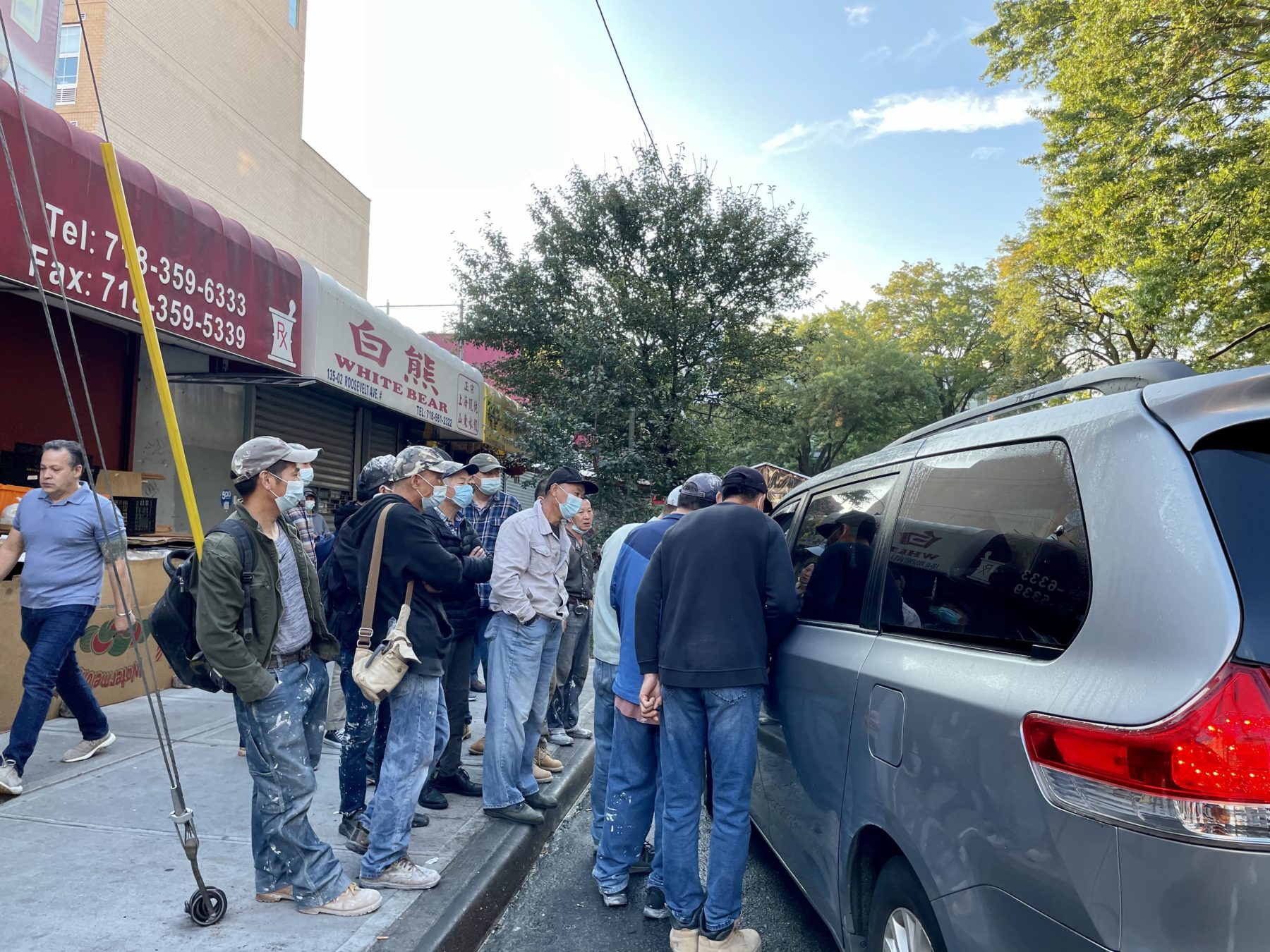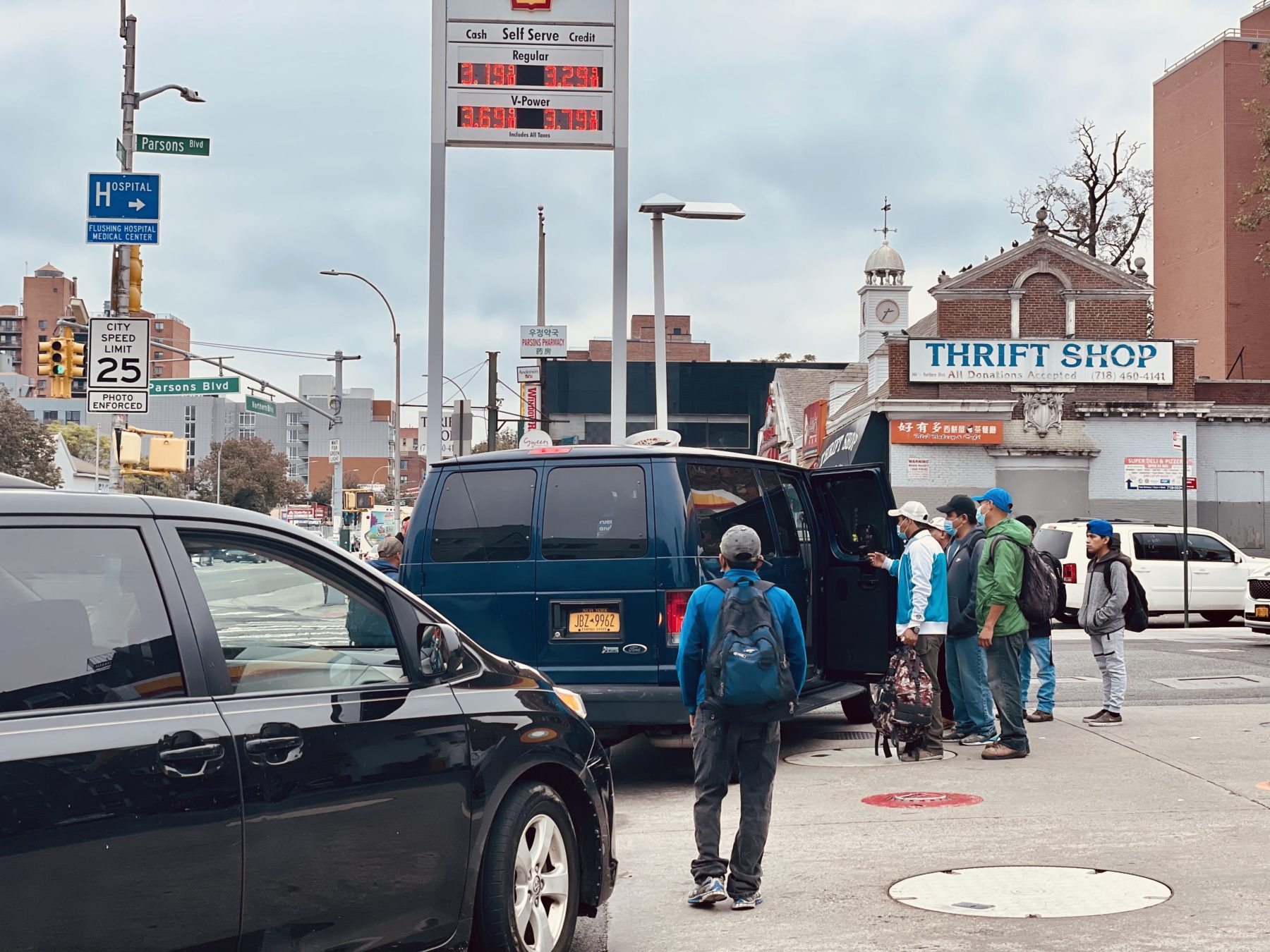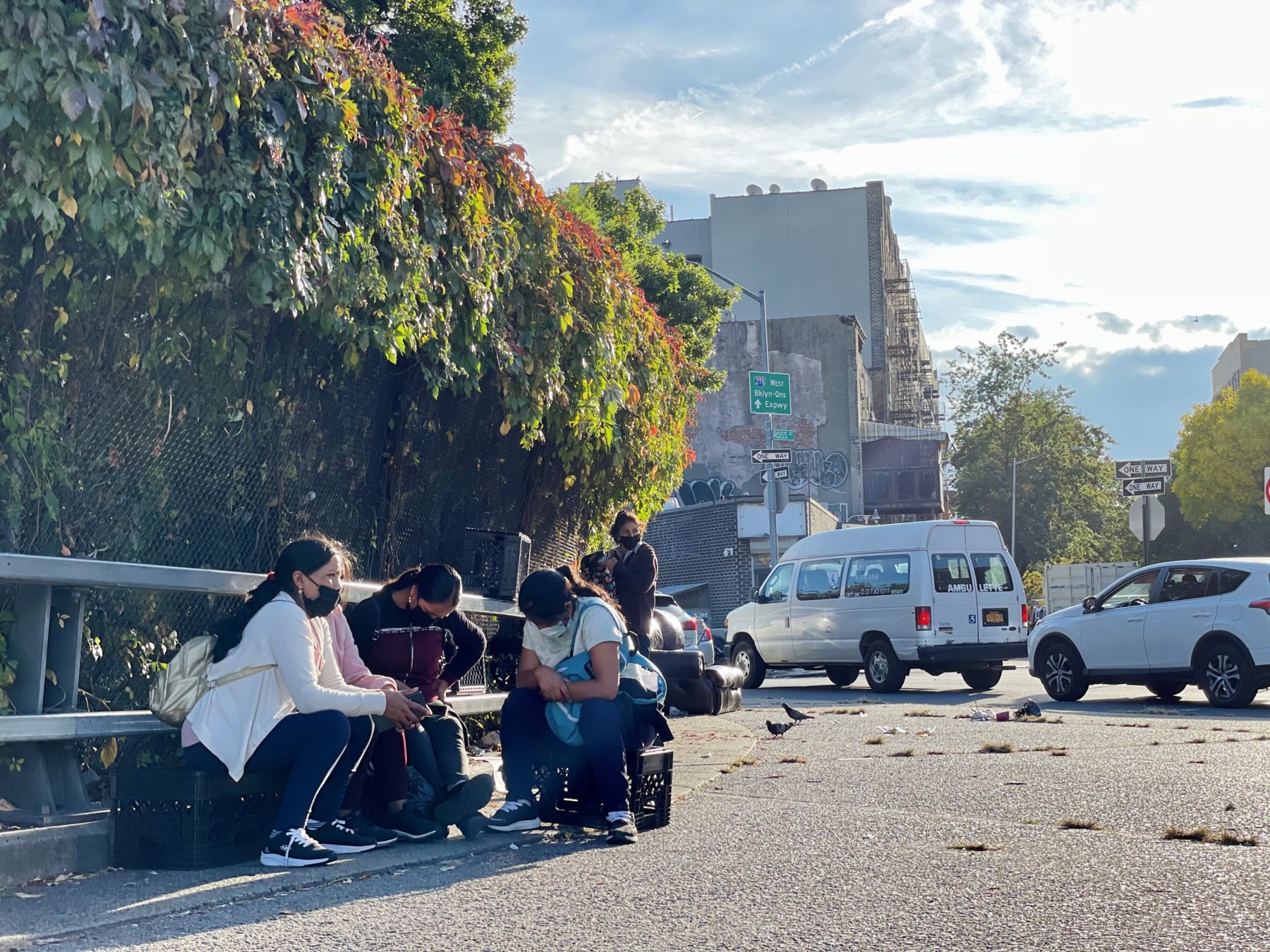
Around dawn on a windy October morning, about 30 Chinese men huddled together at the corner of Prince Street and Roosevelt Avenue in Flushing, Queens.
The first minivan of the day showed up, offering a chance for a shift of work to help cover a down payment on a house in China, or to pay for a delivery truck to achieve a version of the American dream, or just some extra cash to buy sushi for a grandson.
Within seconds, the workers gathered around the silver minivan. Eric Xie, the driver, opened his window and explained in Mandarin that he needed someone who could pour concrete at a residential construction site. He left without finding the right person. “They don’t know how to pour concrete. I don’t want to pay $220 for a person who talks more than he acts,” he says.
Xie eventually called three workers he already knew, paying them $200 a day. His standards aren’t especially high, he said. “I just want to find a hard-working worker who can finish his job,” Xie said.
Usually, though, employers and workers strike a deal on the corner, where they negotiate the price, skills, location and duration of their jobs. Some jobs are based in New York City. Some take workers to New Jersey or other states. From Monday to Saturday, 6:30 to 9:30 a.m., these Chinese immigrant workers gather in this area to find work.
This corner for Chinese immigrants seeking day labor jobs has existed for more than 20 years. It used to be the first place for many new Chinese immigrants to seek jobs right after they landed in New York. Now, younger Chinese immigrants choose to use online apps to search for jobs, and tend to easily get jobs as delivery or restaurant workers. In this day labor market, 50 years-old is considered a young worker, with many in their sixties and one who is 72 years-old, looking for a construction job. The pandemic hit them hard. Jeff Ma, a 66-year-old construction worker who first visited this day labor market in Flushing in 2000, and is still looking for day jobs, told Columbia News Service that many workers don’t share their real age with potential employers. So, many employers will automatically consider workers five years older than what they claimed they are when negotiating for a job.
“Some workers went back to China, some younger or more ambitious ones moved to other states to earn more money, those left here are mostly the elders,” said Hongwei Wang, a 55-year-old employer for a moving company who used to hire in the day labor market.
After the pandemic ravaged the city’s economy, many companies and immigrants have turned to the city’s day-labor markets, where jobs are arranged on the fly, wages are paid in cash, and there are few protections for employees. But the markets also reflect the strains on both sides of the economic spectrum. So for now, at least, experienced construction workers are often hard to find as the pandemic drags on. Given labor shortages, even the most basic jobs, such as hauling garbage, can command $180 per day.
That’s why some employers head to find cheaper labor at another corner of Bowne Street and Northern Boulevard in Flushing , less than a half-mile away, where many of the workers are from Mexico or Guatemala.

A labor market at the corner of Bowne Street and Northern Boulevard in Flushing (Photo: Jiahui Huang)
A man named Liang, who wouldn’t share his last name because he’s worried that hiring undocumented workers may lead to trouble for his small business, is one of those employers seeking less expensive labor in the Latino market. There, according to workers, they get paid about $150 a day — or roughly 20% to 25% less than the Chinese workers can get. The challenge for Liang and other employers is the language barrier. He speaks a little English and almost no Spanish. Sometimes they rely on Google Translate.
Juan Ixtos, 51, from Guatemala, often works for Chinese employers. He said he came to the U.S. in April 2018, and worked as a helper with a Chinese employer at a construction site for a year. He found another job in June 2020, working on a trash truck with another Chinese employer. He now makes $180 a day, cash, for an eight-hour day, six days a week. “I’m happy, and I’m learning Chinese,” he says. He has 10 children, ranging from 3 to 32 years old, and eight of them are still in Guatemala. With his rent at just $400 a month, he can send $700 a week back to his family. “I couldn’t even afford food in Guatemala. There’s no jobs.”
Qiang Huang, 42, says he was laid off from a Chinese restaurant in Ohio in March 2020, when the pandemic broke. He moved to New York “to find more job opportunities,” he says, but with restaurants closed here as well, he headed to the day-labor market in Queens. “It was hard at first. I worked as the helper and got the lowest pay, because I didn’t know anything about how construction works,” Huang said. But now he can handle more skilled work like painting and plastering, and he gets paid around $200 per day.
When he isn’t at a construction site, he uses his bike to deliver food for Fantuan Delivery, a company that services Asian restaurants. His goal is to earn enough to buy a car and become a full-time delivery person: “I like driving. It’s freer, and I can earn more.”
But on this October morning, Huang was having trouble finding a construction gig. As he puffed on a Marlboro, he said that the day before, an employer called “and hired me for a day job in New Jersey. So I’m quite chill today. I earned $200 yesterday. If I cannot get a job today from this market, I’ll just go and do delivery.” And that’s what he did, as he left at around 8:30 a.m. with his bike.
The pandemic has made many immigrants’ lives harder. Working-class Asians faced significant job losses due to their concentration in service industries most affected by the pandemic, according to a recent report by the Asian American Federation, a nonprofit organization that advocates for Asian Americans in the New York metro area. AAF’s report on small business losses showed an estimated 81 percent of Asian-owned small businesses surveyed reported more than 50 percent loss of revenue during the pandemic—if they were not already shut down. Howard Shih, the Research and Policy Director for the Asian American Federation, told Columbia News Service, “we were able to see more recent unemployment data that showed that Asian unemployment rates still haven’t quite recovered to the level that was before COVID.”
Many workers that seek day labor jobs on these corners are undocumented, which makes it even more challenging for them to survive.
Patricia Campos-Medina, executive director of the Worker Institute at Cornell’s School of Industrial and Labor Relations, said that “until the federal government has a solution for our immigration stalemate, we know we will continue to have 11 million undocumented workers, many of them living and working in New York City.” And for unemployed immigrants, there were few aid programs, said Campos-Medina, other than the state’s Excluded Workers Fund, which is now closed.
Irene Colula is one of those immigrants who had to turn to the day-labor market. Before the pandemic, she said, she was making the $15 minimum wage while cleaning houses. Then, she contracted COVID-19 in April 2020, and was hospitalized for two months. “The employer I worked for just found someone else to do the job,” she said. “It was bad, we couldn’t work and spent all of our savings.” Now, she has to seek work at a labor market at the intersection of Marcy Avenue and Division Avenue in Williamsburg, one of the only markets in New York City seeking women laborers. And because of the competition, wages have dropped to between $9 to $13 an hour, she said.

Many immigrants take to the day market to pay down their debts. Hengde Qiu, a 50-year-old Chinese laborer from Fujian, says he worked on construction sites for his first year and a half here, to pay down debts to those who brought him to the U.S. in 2018. After the pandemic took hold in New York City, some of his friends tried to return to China. But he was determined to stay in the U.S., to earn enough money so his 24-year-old son in China could get married and buy a house. He just finished a 30-day construction job in which he earned around $6,000. He sent all but $1,000 of that back home.
He works six days a week, and his dream is to bring his wife to the U.S. to “get a sense of how Americans live.” The day labor market in New York City is just like a mirror of the immigrants’ life. They came here for their version of “American Dream,” or just to simply earn more money for their families. With the pandemic, their lives changed. Twenty years later, the day labor market in Flushing is not as crowded as it was. Qiu said eventually he wants to go back to China after he “earns enough money”. His friend sighed and doesn’t think Qiu is realistic, “We’re migrant workers here, and it won’t change if we go back to China. We’ll still be the migrant workers in China. ”
About the author(s)
Jiahui Huang is a fellow at Toni Stabile Center for Investigative Journalism at Columbia Journalism School.



